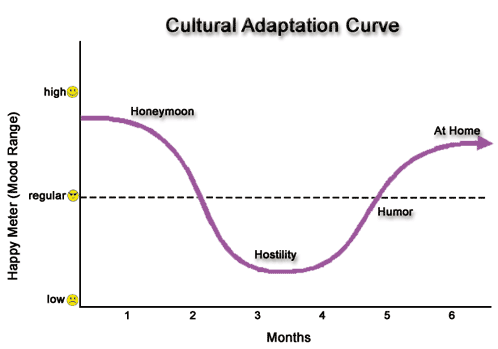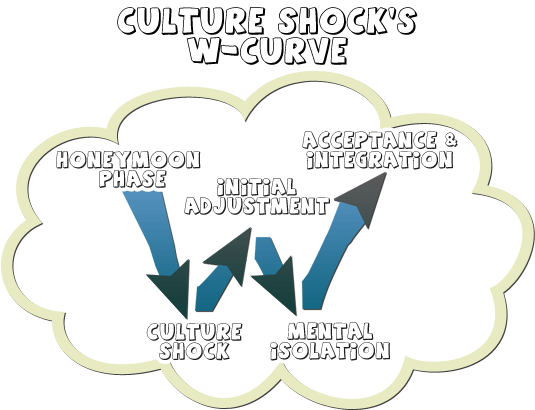Like many of my other blog posts, I’ve been planning this series for ages but needed something to actually spur me into writing and posting them. Here, the impetus has come from Americanah by Chimamanda Ngozi Adichie. This book is perfect; go read it if you’re at all curious about the immigrant experience.
I’ve been in the U.S. for seven years now, and for the first time I think I might be beginning to understand how I fit (or don’t fit) into this society. Seven years is a pretty long time to spend in a country before feeling like one knows what one is doing, and in retrospect there are a few things I wish someone had told me about when I got here. Foremost among these is the culture shock curve.
The culture shock curve is a graph that describes the typical reaction of an immigrant to their new country. First they love it, then they hate it, then they find their situation sort of funny, and finally they accept that this new country is now their home.

This, at any rate, was the culture shock curve that I was shown before I left for my semester abroad, a full two years after I had come to the U.S. Why it didn’t strike anybody that this would be a good thing to show incoming international students, I cannot fathom. At the time, I had just spent over a year in stage two, “hostility”, and I was immensely relieved that this emotional roller-coaster was typical, even if in my case it had gone on much longer than the six months depicted in the graph (and little did I know how much longer it would go!). Since then I’ve made it a point to describe this curve to anybody I meet in a country that isn’t their own.
On searching for this image just now, five years later, I found that this is far from the only version of the culture shock curve. Some variants talk about the “reverse culture shock” you feel when you return to your home country. Others talk about a period of superficial adjustment, and a second low period. I now think this W-shaped curve better fits my experiences than the U-shaped one above.

If you’re an immigrant yourself, or interact with immigrants, it’s critical to realise that this curve is never traversed in isolation. It sits in, is moulded and stretched by, one’s circumstances. And for international students in particular, the circumstances include academia. Flipping things around, you may argue that academic ups-and-downs happen to everyone, and therefore have nothing to do with culture shock. You’d be right about the first part, but wrong about the second—every major up or down in my life offers a new way of interrogating my relationships with the culture I come from and the culture I am in. That interrogation isn’t always pleasant, but it’s always there.
Both the ups and the downs of my culture shock curve have coincided with crucial stages in my academic career. My emergence from the first stage of hostility was facilitated by my first full summer as a field assistant, by realising that I was good at the work I had come to this country to learn to do, by working under the guidance of people I got along with, some of the first Americans with whom I broke past the wall of friendliness-but-not-friendship that felt all but universal in the U.S.
The period of mental isolation in my W-shaped curve coincided with my inevitable mid-grad-school slump. It coincided what appeared to be a failed field season—I didn’t think of it as a failure, but the look of well-intentioned pity on my colleagues’ faces suggested that it seemed otherwise. It coincided with switching study organisms, a switch I was fully prepared for, but which was still nerve-wracking. It coincided with three failed grant applications, which were admittedly terrible applications, and with the frustration of not being able to express what I thought were perfectly sensible research plans.
I think I’m now getting out of this doubly low period, in large part because of a decent field season, which means I now have some pretty interesting data and a solid idea of what I’m doing. But this season was important for me for one other crucial reason—it was my first independent field season in the U.S. All my previous independent field work had been in India, and even though working alone in new parts of India put me out of my comfort zone, I knew approximately what to expect. It may strike you as ridiculous that I was more nervous for a field season in Gainesville, FL, than for fieldwork in seven different cities/towns/villages, none of which I had been to before, across peninsular India; however, it makes perfect sense to me and, I hope, makes sense to other international students. My field season in FL was going to be a test of whether I had figured out how to function in a country that isn’t mine.
And I managed. I now know that even though I’ll never quite “fit in” in the U.S. in the way I had previously hoped , I’ll manage to get things done. Not only is this all I can really expect, it is now also all I want. I don’t want to fit in, and I’m hoping this realisation signals the end of my seven-year-long roller-coaster of culture shock.
Thanks, Ambika. I experienced many of the same emotions when I moved to Spain. And that was compounded by the fact that I am actually part Spaniard by ancestry and felt the additional shame of not fully fitting in to a culture that was supposed to be my own. I’ll keep this post in mind as I adjust to life in Australia.
I’m glad it resonates, Martha! Good luck with your move to Australia–you are undoubtedly going to kick ass!
And now I’ve moved on to “Initial Adjustment” here in Australia. I have seriously thought about this post so much since moving here! 🙂